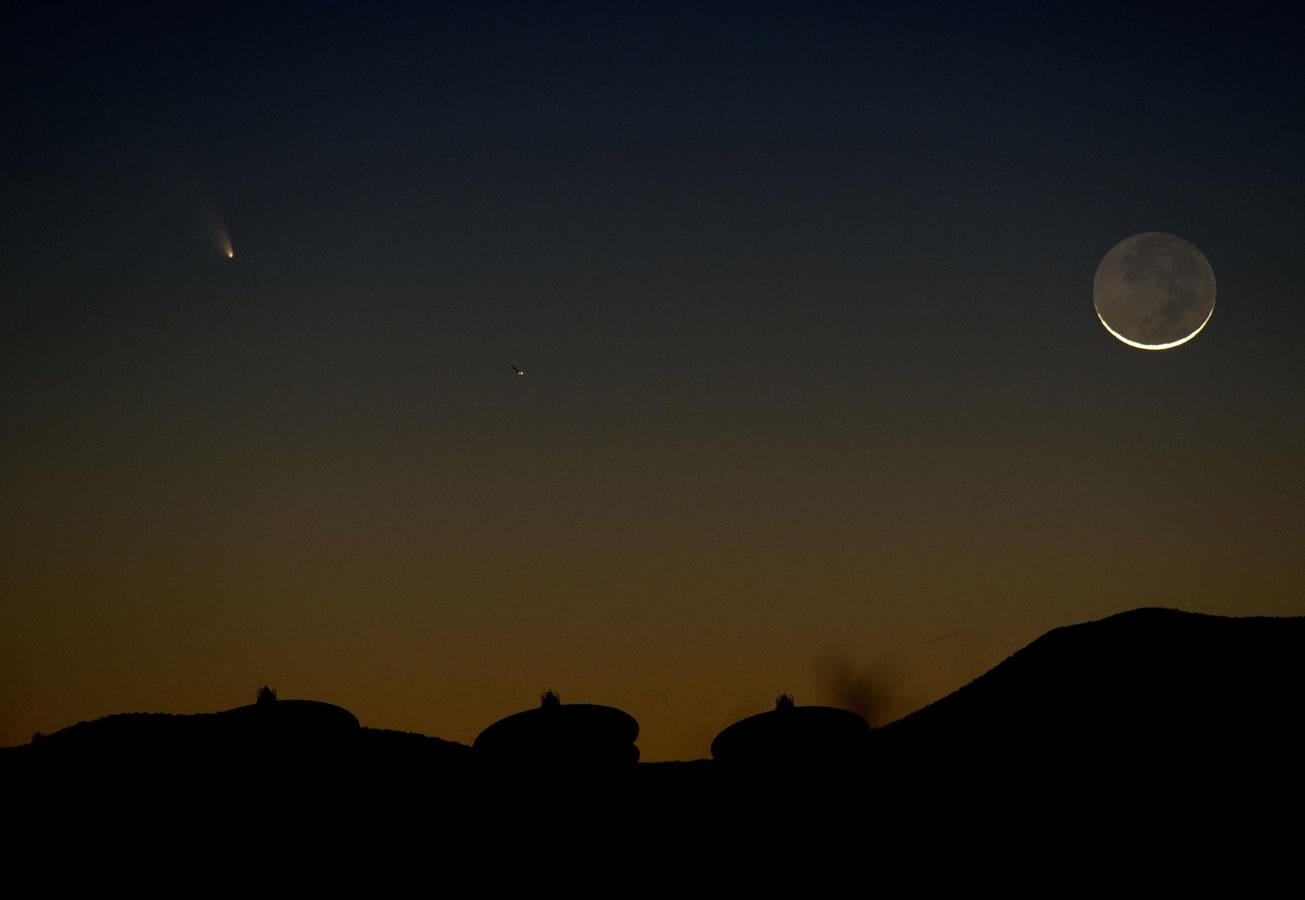Topline
Have you seen the comets yet? Comets Lemmon (C/2025 A6) and SWAN R2 (C/2025 R2) — also known as the “green comets” — are currently shining in the post-sunset night sky. From Thursday, Oct. 23, a delicate crescent moon will hang close by, making for a spectacular combination rarely seen in the night sky.
Comet PanSTARRS (L) is seen with a one-day old crescent moon as both set over the Very Large Array radio telescope antenna dishes March 12, 2013 near Magdalena, New Mexico. The comet, now just faintly visible in the northern hemisphere, was discovered in June 2011 by the Panoramic Survey Telescope and Rapid Response System (PanSTARRS) in Hawaii. AFP PHOTO/Stan HONDA (Photo credit should read STAN HONDA/AFP via Getty Images)
AFP via Getty Images
Key Facts
Comet Lemmon and Comet SWAN R2 both got closest to Earth on Oct. 21, but are expected to remain visible until early November. However, this is the last peak weekend for both comets as they begin to fade from view.
The crescent moon will be 5%-lit on Thursday, Oct. 23, 10%-lit on Friday, Oct. 24, 16%-lit on Saturday, Oct. 25 and 24%-lit on Sunday, Oct. 26. During this time, it will be visible in the west, moving towards the southwest, after sunset.
The brighter Comet Lemmon is in the northern sky, in the constellation Canes Venatici, west of the Big Dipper. The fainter Comet SWAN R2 will be visible in binoculars in the constellation Aquila, beneath the vast Summer Triangle asterism of three bright stars.
On Thursday, Oct. 23, a very slim crescent moon — emerging from its new moon phase — will shine close to Mercury and Mars just after sunset.
Last Chance For Two Comets
In a rare coincidence, two comets — bright Lemmon and fainter SWAN R2 — got their closest to Earth earlier this week. That makes the weekend of Oct. 24-26 the last peak viewing window before they fade. After passing closest to Earth, the comets remain bright enough to be seen faintly under dark skies and vividly in binoculars. After this weekend, both comets will continue drifting farther from Earth and dim steadily. So for Northern Hemisphere skywatchers, this weekend is the last best chance to catch these “comets of the year.”
The Night Sky Next Week
While both comets will remain going concerns next week, the moon will gradually steal the show, culminating on Thursday, Nov. 6, as a full beaver moon. Its light will make seeing the comets harder, particularly since it’s the first “supermoon” of 2025 and the biggest since late 2019. It will appear to be about 10% larger than on average because it’s closer to Earth, the cause being the moon’s slightly elliptical orbit of Earth. On Sunday, Nov. 9, a 71%-lit waning gibbous moon will hang close to bright planet Jupiter as well as Pollux, one of the “twin” stars of Gemini.
The times and dates given apply to mid-northern latitudes. For the most accurate location-specific information, consult online planetariums.
Check my feed every day this month for a daily “comet tracker” with finder charts and tips for viewing Comet Lemmon and Comet SWAN from mid-northern latitudes. Also read How To Photograph The Green Comets, Best Stargazing Apps For Finding The Comets and 25 Dark Sky Parks In The U.S. To See The Comets.
Further Reading
First Appeared on
Source link













